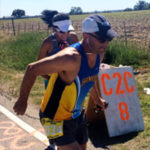Fuel Up the Right Way Before Hitting the Trail

Coach Greg
Properly training for your first major run or walk event will ensure a memorable day— for all the right reasons. But don’t forget the many weeks and months of workouts are about more than adapting to physical exertion.
All that time and work gives ample time to experiment with hydration and nutrition. General guidelines exist, but what combination of food and drink works is something each of us must figure out for ourselves. Moreover, what works for us at shorter event distances may not be enough for what we need to participate in longer events.
The 2018 Austin Marathon taught me this lesson. I ran the first 22 miles more or less according to my plan and even ran some faster miles in the latter half of the race (what you’ll hear termed as a negative split). But the last three miles of the race, I was solidly up against that fabled “wall.” Finishing that final 10 percent of the race was a challenge I hadn’t expected, and that was primarily because I didn’t eat sufficient calories for the amount of miles I logged that day.
It was my first marathon, and I simply didn’t realize the energy demand. And I have no doubt that what I did eat failed to have the correct balance of carbohydrates, fats and proteins.
In short, we need all three food types when exerting ourselves over long miles, often for three hours or more. Generally, our body turns to carbohydrates first for energy, and is why you often hear about “carbo loading.” However, the exact mixture of carbs, fats and proteins is very individualized to each of us; so we must experiment with a balance of foods to find what best provides us sufficient energy. To be sure, along the way we also will learn what does or doesn’t upset our stomach or cause urgent visits to the latrine.
Finally, timing is key. When we eat has as much to do with success as what we eat.
My “go-to” for figuring this out is Runner’s World Complete Guide to Nutrition. This handy booklet published in 2016 is packed with great information, but especially helpful is the section titled Eat by the Clock:
“When you’re training, time is of the essence, says sports nutritionist Drew Price. “Nutrient timing is the secret weapon employed by professional athletes to fuel training, power race day, and support recovery. Carbs are obviously important for energy on your run and to recover afterward, but so is protein because it improves carb usage and supports muscle recovery. Fat and fiber should be limited as they slow the transition of food throughout the gut and can cause gastric distress.”
It goes on to explain that fueling up ideally begins as many as two hours before an event. This section of the booklet details what goes into your body should become increasingly simpler as the event time approaches. For example, you might begin by eating something like pasta two hours before your event, but 15 minutes before the start time you might eat an orange.
The key here is that you should be fueling up in stages and not in one large meal. Case in point — carbo loading does not mean eating a giant plate of spaghetti the night before an event. Loading up on carbs is best done over a period of days.
And, more critically, you should continue taking on calories during the event and after you are done. It’s OK if all this sounds a bit complicated. Your weeks of training is your time to sort all of this out. And our Austin Fit group is the perfect forum to share experiences and trade notes.
Please let us know what works for you.
